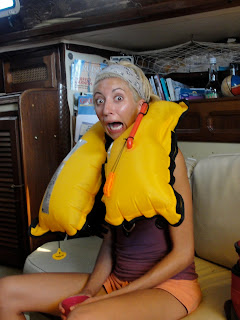Sailing east bound on the north coast of Dominican Republic is slightly challenging. The trade winds never stop blowing here and on the windy days the squalls make it seem crazy to go out sailing. I would not like to make a passage if it blows more than 20 knots in this area. The seas get so choppy and it's almost impossible to not hurt yourself or your vessel. It is what it is; I look at it as training for more difficult passages in the future.
We were ready and happy to leave Luperon. It's very easy to get stock in places like Luperon. The anchorage was so calm and pleasant that we almost forgot the real deal anchorages.
When we left Luperon it was blowing 18 knots. The boat got washed a few times by big waves. We were motorsailing and for the first time the Yanmar inboard engine overheated. In the middle of all these waves we are engine-less. We had to depend on sailing only and I knew that would put us in anchorage in Sosua after sunset. I DON'T like to anchor in a new place when it's dark. I have done it many times but would always prefer to get to anchorage during daylight. We arrived to Sosua at 8pm and anchored 500ft from a reef. Luckily we knew where the reef was! It always feels good to be anchored after an exausting passage. And ashore it seems like there is lots of life. But we were too tired to go ashore right away, maybe mañana.
With swells still coming in, a swell bridle makes the sleep at night more pleasant. A swell bridle is a type of anchoring technique that puts the noise of your boat into the wave so instead of moving side to side you move up and down.
One beautiful thing with anchoring at night is that when you wake up in the morning you are in a new world. We realized shortly after we woke up that Sosua is a tourist destination. A couple of Tip Top catamarans anchored next to us and people were getting in the water to snorkel and ride the banana boat and do other water sports.
Soon I noticed that the main anchor line was loose; I tried to tie it up and the whole line was detached from the chain. Luckily, there is always a safety line connected to the chain in case one line breaks. The bolt to the shackle connected to the chain unscrewed and the line got disconnected. I put a new shackle in there and I dove to find the old bolt but no luck.
The best time to make passages in this area is at night when the night lee kicks in and reduces the trade winds. But you have to stay close to shore for an enjoyable sail.
 |
| Demonstration of inflated PF |
The swells were moderate and wind was 8 to 10 knots.
So we had the jib and main sail out and had a good sail.
However, the jib would not fly right and it couldn't adjust.
After an hour of sailing I discovered that the seam that
holds the ring connected to the jib halyard on the top
was coming loose. By the time we furled in the jib
the top was totally disconnected from the halyard. It's
dark and you can't see much and while we are furling
in the jib, the pull tab to my PFD gets caught on
something and suddenly the life vest blew up. Talk
about when it rains it pours! As I always say, things
break but as long as nobody gets hurt and the vessel
is operable, it's ok!
Today we worked on the jib and had a quick fix for it till we find a sail maker that can sew the seam.
We are staying put here in Rio San Juan till the weather comes down some and then we are going to sail toward Samana.
Love from Rio San Juan

That is a truly amazing photograph!
ReplyDeleteEnjoy your blog. I wish we had known you were coming through St. Louis - we live only 2 miles from the arch
Deb
S/V ??? (no name yet)
Www.theretirementproject.blogspot.com
Thanks Deb,
ReplyDeleteI stopped in St. Louis for few days on the way down to the gulf.
Cheers